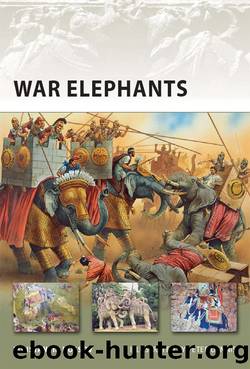War Elephants by Konstantin Nossov

Author:Konstantin Nossov
Language: eng
Format: epub
Tags: War Elephants
ISBN: 9781780966236
Publisher: Bloomsbury Publishing
Published: 2012-02-16T16:00:00+00:00
A terracotta figure of a war elephant with a tower. It is hard to assert with confidence whether it is an African or an Asian elephant. Judging by the ratio between the figures of the man and the animal, it is African. In this case, the figure proves that African forest elephants did carry towers. (National Archaeological Museum, Naples)
Hardly was the First Punic War over when Carthage found itself drawn into another conflict, known as the Mercenary or Truceless War (241–237 BC). The bulk of the Carthaginian army consisted of mercenaries. When the government failed to pay them the promised salary, they rebelled and even besieged Carthage. Salvation came with Hamilcar Barca and his force of war elephants. In the final battle, Hamilcar, with only 10,000 men and 70 elephants against 25,000 mercenaries, lured the latter in the centre with a sham retreat and suddenly attacked them with his cavalry and elephants. The rebels suffered a complete defeat.
In 218 BC, the Second Punic War began and the famous Carthaginian general Hannibal traversed the Alps to invade Italy with an army that included 37 war elephants, mostly African. In the course of that arduous crossing, he lost a considerable number of infantrymen, cavalry and draught animals, but not a single elephant, if the ancient sources are correct. The war elephants’ contribution to Hannibal’s first victory in Italy, on the Trebbia River, was great indeed. They frightened the Roman cavalry and routed Roman auxiliaries. Shortly after the battle, however, all but one elephant died. We do not know why, but the after-effects of exhaustion suffered during the crossing or wounds or some disease incurred during the campaign are all distinct possibilities.
Eighty elephants fought for the Carthaginians in the battle of Zama in 202 BC. Recently caught and poorly trained, they played no decisive role, partly owing to the Romans’ stratagem: they let the elephants through passages purposely left in their formations. Defeated in the Second Punic War, which ended in 202 BC, Carthage was forbidden to keep war elephants. In 149 BC the Romans found a pretext to launch the Third Punic War, which put an end to Carthage in 146 BC. The war had begun unexpectedly and the Carthaginians had no time to equip themselves with war elephants.
Download
This site does not store any files on its server. We only index and link to content provided by other sites. Please contact the content providers to delete copyright contents if any and email us, we'll remove relevant links or contents immediately.
| Anatomy | Animals |
| Bacteriology | Biochemistry |
| Bioelectricity | Bioinformatics |
| Biology | Biophysics |
| Biotechnology | Botany |
| Ecology | Genetics |
| Paleontology | Plants |
| Taxonomic Classification | Zoology |
Sapiens: A Brief History of Humankind by Yuval Noah Harari(13048)
The Tidewater Tales by John Barth(12029)
Do No Harm Stories of Life, Death and Brain Surgery by Henry Marsh(6335)
Mastermind: How to Think Like Sherlock Holmes by Maria Konnikova(6234)
The Thirst by Nesbo Jo(5783)
Why We Sleep: Unlocking the Power of Sleep and Dreams by Matthew Walker(5639)
Sapiens by Yuval Noah Harari(4534)
Life 3.0: Being Human in the Age of Artificial Intelligence by Tegmark Max(4502)
The Longevity Diet by Valter Longo(4445)
The Rules Do Not Apply by Ariel Levy(3905)
The Immortal Life of Henrietta Lacks by Rebecca Skloot(3826)
The Body: A Guide for Occupants by Bill Bryson(3797)
Why We Sleep by Matthew Walker(3771)
Animal Frequency by Melissa Alvarez(3754)
Yoga Anatomy by Kaminoff Leslie(3700)
Barron's AP Biology by Goldberg M.S. Deborah T(3631)
The Hacking of the American Mind by Robert H. Lustig(3579)
All Creatures Great and Small by James Herriot(3514)
Yoga Anatomy by Leslie Kaminoff & Amy Matthews(3394)
